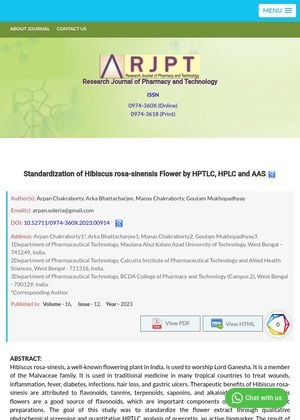TLDR The method ensures Hibiscus rosa-sinensis flower extract is safe and effective for medicinal use.
The study aimed to standardize the extract of Hibiscus rosa-sinensis flowers using qualitative phytochemical screening and quantitative HPTLC analysis of quercetin, an active biomarker. HPTLC analysis found 0.33% quercetin, while HPLC found 0.37% quercetin. Heavy metals and trace elements were measured using atomic absorption spectroscopy (AAS), showing that levels of cadmium, lead, arsenic, copper, chromium, and mercury were within acceptable limits. This standardization method ensures better efficacy and safety for raw materials and finished products.
June 2023 in “Journal of Natural Remedies” Hibiscus rosa sinensis may help manage hair loss.
4 citations
,
May 2021 in “Research Journal of Science and Technology” Hibiscus rosa sinensis shows promise for treating various health conditions and promoting hair growth.
 24 citations
,
August 2018 in “Journal of Ayurvedic and herbal medicine”
24 citations
,
August 2018 in “Journal of Ayurvedic and herbal medicine” Hibiscus rosa-sinensis may help treat various health issues and promote hair growth, but more research is needed for safety.
 1 citations
,
January 2017 in “Pharmaceutica Analytica Acta”
1 citations
,
January 2017 in “Pharmaceutica Analytica Acta” The research confirmed that certain methods are reliable for standardizing Eclipta alba and ensuring its safety and quality in herbal products.
 21 citations
,
January 2019 in “Elsevier eBooks”
21 citations
,
January 2019 in “Elsevier eBooks” Green-synthesized nanoparticles can effectively target cancer cells, reducing side effects and improving treatment.
 4 citations
,
January 2016 in “Journal of analytical & bioanalytical techniques”
4 citations
,
January 2016 in “Journal of analytical & bioanalytical techniques” The herbal hair gel could be a safe hair growth treatment with minimal side effects.
3 citations
,
December 2021 in “Frontiers in Pharmacology” Ficus benghalensis leaf extracts can effectively promote hair growth and inhibit hair loss.
 June 2022 in “International journal of drug delivery technology”
June 2022 in “International journal of drug delivery technology” Convolvulus arvensis ethanolic extract can potentially promote hair growth and reduce hair loss.
 13 citations
,
October 2012 in “Free Radicals and Antioxidants”
13 citations
,
October 2012 in “Free Radicals and Antioxidants” The red Hibiscus rosa-sinensis flower has the highest antioxidant activity.






